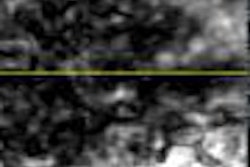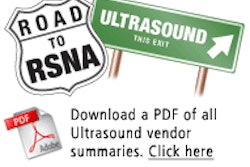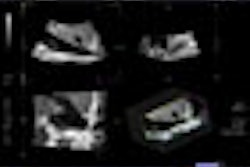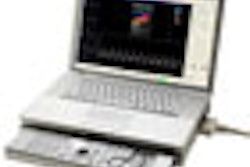Advocates of ultrasound contrast have launched a grassroots lobbying effort to persuade the U.S. Food and Drug Administration (FDA) to relax its recent black box warning on the use of two echocardiography contrast agents. The group believes the FDA warning was unnecessarily strident given the safety profile of ultrasound contrast, and that the warning could hamstring further clinical use of cardiac ultrasound contrast.
The warning was issued in October 2007 after the FDA had received reports of 11 deaths that occurred between 2001 and 2007 that may have been related to ultrasound contrast administration. Four deaths were caused by cardiac arrest occurring either during infusion or within 30 minutes following administration of the contrast agent; 199 serious nonfatal reactions were also reported, many of which also occurred either during or within minutes of administration of the ultrasound contrast agent.
In the warning, the FDA stated that patients with acute myocardial infarction, clinically unstable or worsening congestive heart failure, respiratory failure, serious ventricular arrhythmias, emphysema, pulmonary emboli, and certain types of cardiac shunts should not be given the contrast agents. Patients receiving the contrast agents must be monitored during the infusion and for 30 minutes following the completion of administration.
A month later, advocates for ultrasound contrast began organizing a response. On November 10, 161 cardiologists, radiologists, and other medical imaging professionals sent a letter to Dr. Rafel Rieves, acting director of the FDA's Division of Medical Imaging and Hematology Products in the Center for Drug Evaluation and Research's Office of Oncology Drug Products.
The letter requested that the FDA "convene a panel of cardiologists and cardiac imaging specialists to review the adverse events that have been attributed to the perflutren-containing compounds, and to determine whether there is any evidence for causality," and "if the findings are favorable, to consider withdrawal of the 'black box warnings.'"
The products covered by the warning included Definity, manufactured by Bristol-Myers Squibb Medical Imaging Division of North Billerica, MA, and Optison from GE Healthcare of Chalfont St. Giles, U.K. Due to manufacturing-related issues, Optison was not sold in the U.S. between 2005 and 2007, but recently began to be remarketed.
The letter was written by Dr. Michael Main of the Mid America Heart Institute in Kansas City, MO; Dr. Jonathan Goldman of the University of California, San Francisco; Dr. Paul Grayburn of Baylor University Medical Center in Dallas; and Dr. Steven B. Feinstein of Rush University Medical Center in Chicago.
The 157 additional co-signatories represent academic medical centers and private practices in Australia, Austria, Belgium, Canada, Germany, Greece, Italy, Japan, the Netherlands, Poland, Spain, Switzerland, the U.K., and the U.S. The group includes leading echocardiography authorities, but does not represent any professional medical society.
"These contrast agents have been used for several years. We believe they are critically important in the diagnosis and management of patients with the very conditions now contraindicated by the new FDA guidelines," Main explained.
In November, Main and his colleagues traveled to Silver Spring, MD, to meet with representatives of the FDA's Division of Medical Imaging and Hematology Products.
"We had a very productive meeting," Main said. "We asked the agency to initiate a public discussion as soon as possible through an FDA advisory committee. We are hopeful that the agency is open to reconsidering the labeling for Definity and Optison."
The American Institute of Ultrasound in Medicine (AIUM) also met with the FDA in a teleconference held on November 6. Over the past 12 months, the AIUM had discussions with the FDA with respect to development of a clinical trial testing the efficacy of microbubble contrast for transarterial chemoembolism of liver lesions, according to AIUM immediate past president Dr. Lennard Greenbaum.
"We were in the process of starting to look for funding for the clinical trial when the FDA warning came out," Greenbaum said. "There is a belief that contrast-enhanced ultrasound would be far superior to CT and MR by showing whether or not the treatment would be adequate in a much shorter time frame, within a matter of a week as opposed to months with CT and MR. Unfortunately, the clinical trial initiative has been placed on hold with the black box warning and the contraindications for use."
Societies pitch in
For its part, the American Society of Echocardiography (ASE) has informed its members that it "has been working hard to address this issue on many fronts." On November 28, ASE's president Dr. Thomas Ryan sent a letter to FDA commissioner Dr. Andrew von Eschenbach, "requesting the opportunity to engage in a dialogue" to examine the safety data upon which the FDA decision was based. The society also wishes to examine the factors associated with increased risk and to discuss what additional studies might be done to improve the understanding of these issues.
ASE maintains a Web site devoted to ultrasound contrast-related issues (www.contrastzone.com). The site currently contains expert opinions on the use of contrast agents and will be significantly expanded, according to the ASE. AuntMinnie.com has also been told by a number of prominent ASE members that they met privately with FDA representatives attending the RSNA meeting in November to discuss the matter.
Main and colleagues outlined their case in favor of ultrasound contrast in a recent issue of the Journal of the American College of Cardiology (December 18, 2007, Vol. 50: 25, pp. 2434-2437).
"Although appearing prudent at face value, especially in light of the recent intense focus on patient safety, these strident warnings ignore the proven efficacy of ultrasound contrast agents, the previously established safety of these compounds, the potential risks of alternative procedures, and the effect of pseudocomplication," the authors contend.
"It is important to differentiate between association and causation," according to the authors. "Major cardiac events, including death, are relatively common in patients who are 'sick enough' to warrant invasive cardiovascular testing.... Without knowledge of the ambient event rate, any incremental risk of contrast agents (or any other intervention) cannot be known."
Approximately 2 million patients have received Definity in the past six years. The four deaths that occurred during or immediately following administration of Definity may have been due to pseudocomplication, Main contends. This represents a 1:500,000 risk of death, as compared to a mortality rate of 1:1,000 for diagnostic coronary angiography and 1:2,500 risk of cardiac arrest or myocardial infarction with exercise treadmill testing.
The authors believe that the FDA warnings may trigger significant anxiety on the part of patients and healthcare providers, and that personal injury lawyers may begin advertising for injured clients.
"The requirement to monitor blood pressure and conduct an electrocardiogram for 30 minutes after the procedure will have a chilling effect upon the use of contrast agents," Main said in an interview with AuntMinnie.com. "Echocardiography laboratories typically do not have facilities or personnel to provide prolonged monitoring of ambulatory patients."
Although not confirmed by representatives of Bristol-Myers Squibb, AuntMinnie.com has been informed by several sources who requested anonymity that the FDA warnings have already had a serious negative impact on the use of contrast, with use of Definity in the U.S. dropping by as much as 90%.
Starting a dialog?
Main and his colleagues would like the FDA to utilize clinicians with true cardiac imaging expertise to help judge the safety and efficacy of imaging modalities and the contrast agents used with them. They are hopeful that a dialogue has begun.
Greenbaum told AuntMinnie.com that if data about the deaths associated with microbubble contrast agents would be made available, a multispecialty group of AIUM members would like to conduct an independent investigation to identify the causes of death and safety issues.
"Contrast agents hold promise for use in ultrasound, as has been well proven in Europe," Greenbaum said. "With the FDA warnings, their use may never get off the ground."
In a brief interview, the FDA's Rieves told AuntMinnie.com that "the FDA appreciates the insight of the various medical societies and individual specialists who have contacted us. The FDA is currently working with the manufacturers concerned, and we are hopeful that these initiatives will be positive." Rieves declined to comment in greater detail due to the ongoing nature of the discussions.
By Cynthia Keen
AuntMinnie.com contributing writer
January 3, 2008
Related Reading
Definity to carry warning label, October 12, 2007
U.S. FDA to alert doctors about imaging drugs' risks, October 9, 2007
Left atrial size adds prognostic value in stress echo exams, September 26, 2007
ASE unveils new stress echo guidelines, September 7, 2007
Contrast media add valuable information in US applications, May 4, 2007
Copyright © 2008 AuntMinnie.com



















